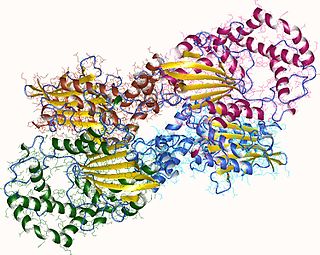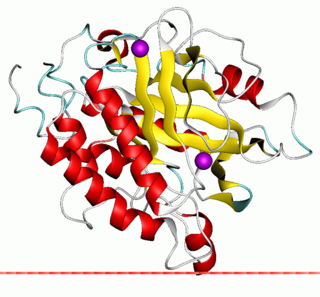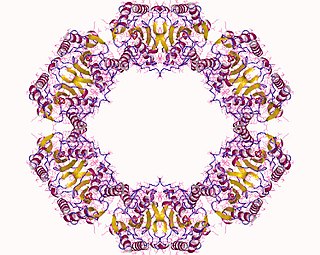Gluconeogenesis (GNG) is a metabolic pathway that results in the generation of glucose from certain non-carbohydrate carbon substrates. It is a ubiquitous process, present in plants, animals, fungi, bacteria, and other microorganisms. In vertebrates, gluconeogenesis occurs mainly in the liver and, to a lesser extent, in the cortex of the kidneys. It is one of two primary mechanisms – the other being degradation of glycogen (glycogenolysis) – used by humans and many other animals to maintain blood sugar levels, avoiding low levels (hypoglycemia). In ruminants, because dietary carbohydrates tend to be metabolized by rumen organisms, gluconeogenesis occurs regardless of fasting, low-carbohydrate diets, exercise, etc. In many other animals, the process occurs during periods of fasting, starvation, low-carbohydrate diets, or intense exercise.

Teichoic acids are bacterial copolymers of glycerol phosphate or ribitol phosphate and carbohydrates linked via phosphodiester bonds.
Hydrolase is a class of enzymes that commonly perform as biochemical catalysts that use water to break a chemical bond, which typically results in dividing a larger molecule into smaller molecules. Some common examples of hydrolase enzymes are esterases including lipases, phosphatases, glycosidases, peptidases, and nucleosidases.

The enzyme glucose 6-phosphatase (EC 3.1.3.9, G6Pase; systematic name D-glucose-6-phosphate phosphohydrolase) catalyzes the hydrolysis of glucose 6-phosphate, resulting in the creation of a phosphate group and free glucose:

Acid phosphatase is an enzyme that frees attached phosphoryl groups from other molecules during digestion. It can be further classified as a phosphomonoesterase. It is stored in lysosomes and functions when these fuse with endosomes, which are acidified while they function; therefore, it has an acid pH optimum. This enzyme is present in many animal and plant species.
sn-Glycerol 3-phosphate is the organic ion with the formula HOCH2CH(OH)CH2OPO32-. It is one of three stereoisomers of the ester of dibasic phosphoric acid (HOPO32-) and glycerol. It is a component of glycerophospholipids. From a historical reason, it is also known as L-glycerol 3-phosphate, D-glycerol 1-phosphate, L-α-glycerophosphoric acid.

The enzyme phosphatidylinositol diacylglycerol-lyase catalyzes the following reaction:
The enzyme alkylacetylglycerophosphatase (EC 3.1.3.59) catalyzes the reaction
The enzyme glucosylglycerol 3-phosphatase (EC 3.1.3.69) catalyzes the reaction
The enzyme glycerol-1-phosphatase (EC 3.1.3.21) catalyzes the reaction

The enzyme phosphatidate phosphatase (PAP, EC 3.1.3.4) is a key regulatory enzyme in lipid metabolism, catalyzing the conversion of phosphatidate to diacylglycerol:
In enzymology, a 2-acylglycerol-3-phosphate O-acyltransferase is an enzyme that catalyzes the chemical reaction
In enzymology, a glycerol-3-phosphate O-acyltransferase is an enzyme that catalyzes the chemical reaction
In enzymology, a diphosphate-glycerol phosphotransferase is an enzyme that catalyzes the chemical reaction

The enzyme protein serine/threonine phosphatase is a form of phosphoprotein phosphatase that acts upon phosphorylated serine/threonine residues:
Glycerol-3-phosphate 2-O-acyltransferase is an enzyme with systematic name acyl-CoA:sn-glycerol 3-phosphate 2-O-acyltransferase. This enzyme catalyses the following chemical reaction
Mannosylfructose-phosphate phosphatase (EC 3.1.3.79, mannosylfructose-6-phosphate phosphatase, MFPP) is an enzyme with systematic name β-D-ructofuranosyl-α-D-mannopyranoside-6F-phosphate phosphohydrolase. This enzyme catalyses the following chemical reaction
Diacylglycerol diphosphate phosphatase (EC 3.1.3.81, DGPP phosphatase, DGPP phosphohydrolase, DPP1, DPPL1, DPPL2, PAP2, pyrophosphate phosphatase) is an enzyme with systematic name 1,2-diacyl-sn-glycerol 3-phosphate phosphohydrolase. This enzyme catalyses the following chemical reaction
D-glycero-β-D-manno-heptose 1,7-bisphosphate 7-phosphatase (EC 3.1.3.82) is an enzyme with systematic name D-glycero-β-D-manno-heptose 1,7-bisphosphate 7-phosphohydrolase. This enzyme catalyses the following chemical reaction

Glycerol 2-phosphate is the conjugate base of phosphoric ester of glycerol. It is commonly known as β-glycerophosphate or BGP. Unlike glycerol 1-phosphate and glycerol 3-phosphate, this isomer is not chiral. It is also less common.







